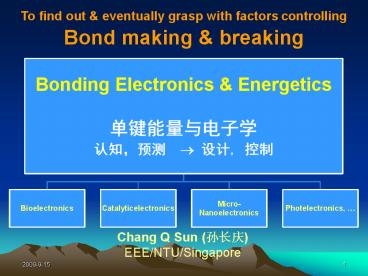Chang Q Sun PowerPoint PPT Presentation
1 / 16
Title: Chang Q Sun
1
To find out eventually grasp with factors
controlling Bond making breaking
Chang Q Sun (???) EEE/NTU/Singapore
2
ChallengeMacroscopic ? Mesoscopic ? Atomistic
Quantum approach for atomistic scales Aniso
tropic Kinetic Localized Strain trap External
stimulus
Classical approach for macroscopic
scales Atomistic origin Statistic
deviation
4-stage Cu3O2 bonding kinetics
3
Objectives
- Set up new horizons of predictive observation
from the perspective of bond formation,
dissociation, relaxation, vibration and the
associated dynamics and energetics of charge
repopulation, polarization, densification and
localization - Predictive design and controllable fabrication of
functional materials and devices - Interplay of theory, experiment, and computation
- Combination of basic studies and applications
4
Established approaches
- BOLS Broken bonds
- Extend Pauling-Goldschmidt theory to energy
domain. - BBB C, N, O chemisorption
- Break boundary between theories in Phys, Chem,
and Surf Sci - LBA Bridge classical quantum theories
- Establish correspondence of detectable quantities
to the geometric energetic response of
representative bonds to applied stimulus - SIQT Surf interface quantum trapping
- transport dynamics of phonon, electron photon
- trapped polarized edge and surface states
5
Local bond making - O, N, and C chemisorption
- BBB correlation applications
6
Bond
Quantification Bond geometry 4-stage bonding
kinetics Bond stress Generalization O-Cu(001),(11
0) O-(Rh, Pd)(110) O-(Co, Ru)(10-10)
O-Rh(111)/Ru(0001) O-(V, Ag)(001) O-Rh(001)/(N,
C)-Ni(001) O-diamond (111) C2H2-Cu(001)
BBB correlation for bond making
- Unification
- STM atomic valences
- PES/STS valence DOS
- TDS bond nature strength
- LEED Geometry bonding kinetics
- EELS/Raman non-bond interaction
- Predictions
- Applications
Band
PZT blue light emission
Barrier
Preferential oxidation of Diamond 111
TiCN
Diamond-metal adhesion
7
II. Bond breaking relaxing- Broken bond v.s.
mesoscopic matter- BOLS correlation
applications
8
The impact of imperfection Atom ? cluster ?
bulk ? Bonds between less-coordinated atoms
become shorter stronger
9
BOLS for bond breaking
- Derivatives
- Predictive unification
- MC, NT, NW, surface, nanograin, nanocavity, etc
- Mechanical strength
- Thermal stability
- Lattice dynamics
- Photon emission PA
- Electronic states
- Magnetic modulation
- Dielectrics
- Transport dynamics
- Quantification
- Energy levels of an isolated atom
- Vibration of an isolated dimer
- Specific heat per bond
- Single bond energy
- Bonding identities in MC CNT
10
Thematic reports published
11
III. Bond relaxing and vibrating-LBA
approachTemperature Pressure
- For a given specimen, the nature and the total
number of bonds do not change under external
stimulus unless phase transition occurs. However,
the length and strength of the bonds will
response to external stimulus.
12
IV. Current focus
- Nanophase under pressure
- Phonon compression transportation
- Charge trapping transportation
- Energy levels of isolated atoms
13
V. Prospects
- Hydrogen storage generation?
- Polymer conductivity superconductivity?
- Fluoride actants in synthetic blood?
- O, N, C, B induced superconductivity?
14
Computation ? Theory ? Experiment
- Transport dynamics (electron, phonon, photon)
- Acoustic, electronic and optic behavior under T,
P, E, B, - Reaction dynamics kinetics
- Energy levels of isolated atoms
Defects/cavities/impurities trapping - Interface mixing and trapping
- Liquid glass states
- Joint effect of bond making breaking
15
Conclusion Just touched the surface, there is
indeed plenty of rooms for further
exploration Synergized efforts could lead to
knowledge substance that would be even more
fascinating promising!
16
Thank you! J Colligon, S Veprek, CL Bai, DSY
Tong, SX Dou, W Gao, MF Ashby, P Jennings, A
Stelbovics, Q Jiang, WT Zheng, SY Fu, J Zhou, YC
Zhou, EY Jiang DH Feng, Alan MacDirmid LK Pan,
WH Zhong, MX Gu, ZW Chen, Ouyang G

